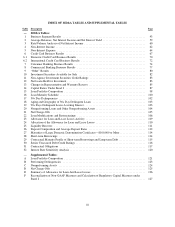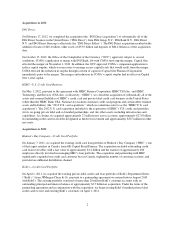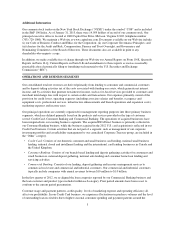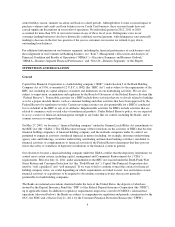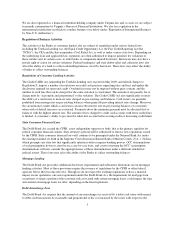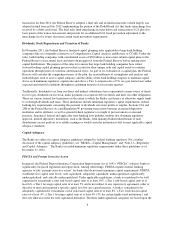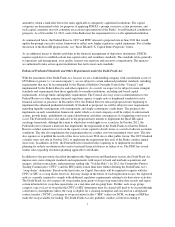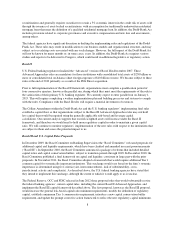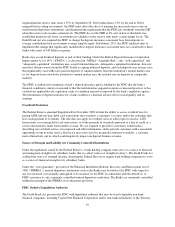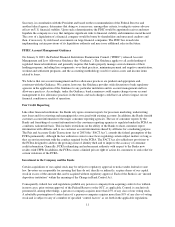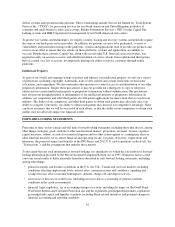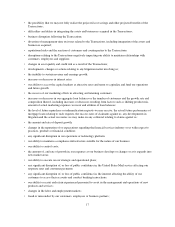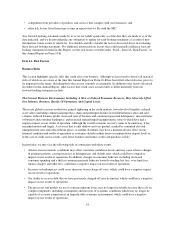Capital One 2012 Annual Report Download - page 28
Download and view the complete annual report
Please find page 28 of the 2012 Capital One annual report below. You can navigate through the pages in the report by either clicking on the pages listed below, or by using the keyword search tool below to find specific information within the annual report.For those institutions subject to the Basel II Advanced Approaches framework discussed above, the proposal
would also implement a supplementary leverage ratio that incorporates a broader set of exposures in the
denominator and would introduce a new countercyclical capital buffer requirement. The second proposal, known
as the Standardized Approach proposal, would revise the federal banking agencies’ general approach for
calculating risk-weighted assets to reflect a more risk-sensitive risk-weighting approach and remove reliance on
external credit ratings, as required by Section 939A of the Dodd-Frank Act. The third proposal would modify the
existing Basel II rules for calculating risk-weighted assets by implementing elements of the Basel III framework
and removing reliance on external credit ratings. As discussed above, under the Collins Amendment within the
Dodd-Frank Act, organizations subject to the Basel II rules must calculate their risk-based capital under both the
Standardized Approach and the Advanced Approach and use the lower of each of the relevant capital ratios to
determine whether it meets the minimum risk-based capital requirements.
The proposed rules would go into effect according to different start dates and phase-in periods. If finalized as
proposed, the rules would increase the minimum capital that we and other institutions would be required to hold.
In December 2010, the Basel Committee also published a liquidity framework, which was subsequently amended
in January 2013. The liquidity framework includes two standards for liquidity risk supervision, each subject to
observation periods and transitional arrangements. One standard promotes short-term resilience by requiring
sufficient high-quality liquid assets to survive a stress scenario lasting for 30 days. This standard, the liquidity
coverage ratio (“LCR”), is included in the amended liquidity framework. The other standard promotes longer-
term resilience by requiring sufficient stable funding over a one-year period, based on the liquidity characteristics
of assets and activities. This standard remains under development by the Basel Committee. We expect that
minimum liquidity requirements for us and other institutions will increase as a result of the Basel III liquidity
framework, though rules implementing the Basel III liquidity framework have not yet been proposed by the U.S.
federal banking agencies.
We will continue to monitor regulators’ implementation of the new capital and liquidity rules and assess the
potential impact to us.
Market Risk Capital Rule
A market risk capital rule, which the federal banking regulators amended in August 2012, supplements both the
general risk-based capital rules and the Basel II Advanced Approaches rules by requiring institutions subject to
the rule to adjust their risk-based capital ratios to reflect the market risk in their trading activities. The rule
applies to institutions with aggregate trading assets and liabilities equal to the lesser of (i) 10 percent or more of
total assets or (ii) $1 billion or more. We are not yet subject to this rule but may become subject to it in the
future.
Deposits and Deposit Insurance
Each of CONA and COBNA, as an insured depository institution, is a member of the DIF maintained by the
FDIC. Through the DIF, the FDIC insures the deposits of insured depository institutions up to prescribed limits
for each depositor. The DIF was formed on March 31, 2006, upon the merger of the Bank Insurance Fund and the
Savings Association Insurance Fund in accordance with the Federal Deposit Insurance Reform Act of 2005 (the
“Reform Act”). The Reform Act permits the FDIC to set a Designated Reserve Ratio (“DRR”) for the DIF. To
maintain the DIF, member institutions may be assessed an insurance premium, and the FDIC may take action to
increase insurance premiums if the DRR falls below its required level.
Prior to passage of the Dodd-Frank Act, the FDIC had established a plan to restore the DIF in the face of recent
insurance losses and future loss projections, which resulted in several rules that generally increased deposit
insurance rates and purported to improve risk differentiation so that riskier institutions bear a greater share of
insurance premiums. The Dodd- Frank Act reformed the management of the DIF in several ways: raised the
minimum DRR to 1.35% (from the former minimum of 1.15%) and removed the upper limit on the DRR;
9



